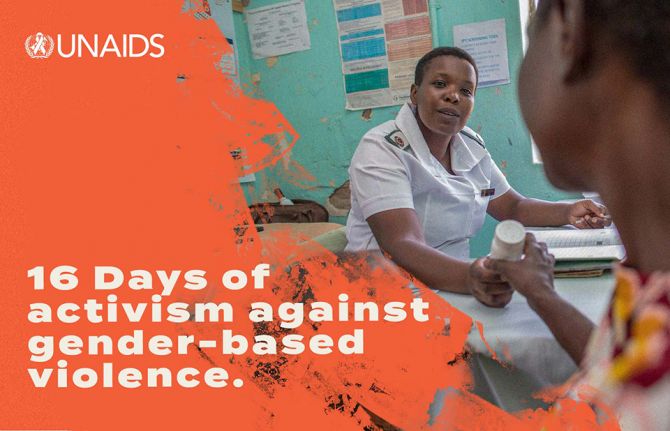

Press Statement
UNAIDS Executive Director urges action to turn the tide on violence against women and girls and HIV
24 November 2021 24 November 2021“Ending gender-based violence requires a whole-of-government, whole-of-society approach. But I am convinced that if decision-makers, at a minimum, push on these key actions, we will have a win–win for everyone: less violence against women and girls and fewer women and girls acquiring HIV or falling through the cracks in accessing and staying on antiretroviral therapy. We must revolutionize the ways of doing business in the AIDS response. Gender equality and women’s rights must be at the centre. There is no room for complacency or acceptance of gender-based violence if we are to end AIDS as a public health emergency by the 2030 deadline for achieving the Sustainable Development Goals,” said Winnie Byanyima, Executive Director of UNAIDS.
One in three women and adolescent girls around the world endure physical and/or sexual violence from their husbands, male partners or strangers. This violence takes place in their homes and neighbourhoods, where they should be safest. And this staggering statistic doesn’t count the millions more women and girls facing a myriad of other forms of gender-based violence and harmful practices. Under COVID-19, reports of intimate partner violence, child and forced marriage, female genital mutilation and sexual violence have only increased.
For women and girls living with HIV, the risks of violence multiply, including from their intimate partners, families and communities or when they seek services. Among its many consequences and costs, gender-based violence undermines hard-won gains in preventing HIV and ending AIDS as a public health emergency.
In countries with high HIV prevalence, intimate partner violence can increase the chances of women acquiring HIV by up to 50%. Violence or the fear of it blocks women’s access to services and their ability to negotiate condom use with perpetrators, disclose their HIV status or stay on HIV treatment.
Many women living with HIV also experience discrimination and sexual and reproductive rights violations in health facilities. Female sex workers, women who use drugs and bisexual and transgender people face exceptionally high risks of both HIV and gender-based violence and sexual assault, fuelled by HIV-related stigma, discrimination and criminalization.
Five key actions
In line with the United Nations General Assembly Political Declaration on HIV and AIDS: Ending Inequalities and Getting on Track to End AIDS by 2030, Ms Byanyima urges governments, United Nations agencies, donors, service providers and all stakeholders in the HIV response to immediately and systematically address the interlinkages of HIV and violence against women and girls, in all their diversity, including by:
- Getting with the basics: at a minimum, countries should comply with international standards for health-service provision for women and girls living with or at higher risk of HIV, integrating prevention and response measures to gender-based violence across HIV services, including for women from key populations, and ensuring protection of sexual and reproductive health and rights.
- Starting early on HIV and gender-based violence prevention: work with adolescent girls and boys to tackle harmful gender norms by investing in gender-transformative education and interventions, including comprehensive sexuality education, instilling values of respect for bodily autonomy, sexual consent, safe dating and use of condoms as the norm, and ensuring zero tolerance for gender-based violence and HIV stigma and discrimination in schools.
- Going beyond engaging men to seek HIV services: leverage HIV programmes engaging men and boys to incorporate gender-transformative approaches that challenge harmful masculinities fuelling both HIV and violence against women and girls. Men and boys should be engaged in HIV testing and treatment uptake alongside efforts to ensure respect of women’s sexual and reproductive health and rights and their rights to be free of gender-based violence.
- Ending impunity for violence against women and girls living with HIV: fast-track legal reforms and enforcement to uphold the human rights of all women to live free from violence, regardless of their HIV status or any other grounds, and end the overuse of criminal laws that target or disproportionately impact on women because of their sexuality, sexual activity, HIV status, gender or drug use. Expand legal and human rights literacy among women and girls living with or at risk of HIV so they know their rights and where to seek legal aid and access justice, and ensure that complaint and redress mechanisms for gender-based violence and reproductive rights violations are accessible across health and other services.
- Investing in women’s leadership to turn the tide on both HIV and gender-based violence: institute mechanisms for the meaningful participation and leadership of women and girls living with and at risk of HIV, in all their diversity, in decision-making for responding to the twin pandemics of AIDS and violence against women and girls. Invest in feminist leadership and women-led HIV community-based interventions, and value their experiences and expertise as central to an effective HIV response.
UNAIDS
The Joint United Nations Programme on HIV/AIDS (UNAIDS) leads and inspires the world to achieve its shared vision of zero new HIV infections, zero discrimination and zero AIDS-related deaths. UNAIDS unites the efforts of 11 UN organizations—UNHCR, UNICEF, WFP, UNDP, UNFPA, UNODC, UN Women, ILO, UNESCO, WHO and the World Bank—and works closely with global and national partners towards ending the AIDS epidemic by 2030 as part of the Sustainable Development Goals. Learn more at unaids.org and connect with us on Facebook, Twitter, Instagram and YouTube.
